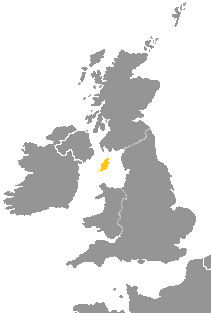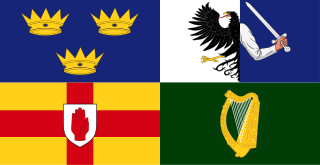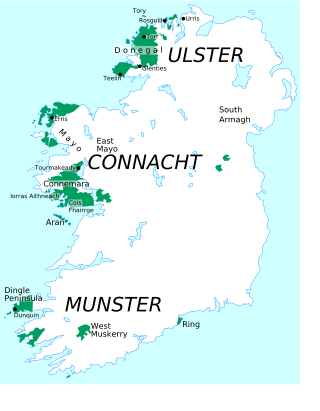Related Research Articles

Loch is a word meaning "lake" or "sea inlet" in Scottish and Irish, subsequently borrowed into English. In Irish contexts, it often appears in the anglicized form "lough".

Manx, also known as Manx Gaelic, is a Gaelic language of the insular Celtic branch of the Celtic language family, itself a branch of the Indo-European language family. Manx is the historical language of the Manx people.

Aos sí is the Irish name for a supernatural race in Celtic mythology – daoine sìth in Scottish Gaelic – comparable to fairies or elves. They are said to descend from the Tuatha Dé Danann, meaning the 'People of Danu', depending on the Abrahamic or pagan tradition.

A leprechaun is a diminutive supernatural being in Irish folklore, classed by some as a type of solitary fairy. They are usually depicted as little bearded men, wearing a coat and hat, who partake in mischief. In later times, they have been depicted as shoe-makers who have a hidden pot of gold at the end of the rainbow.
Irish orthography is the set of conventions used to write Irish. A spelling reform in the mid-20th century led to An Caighdeán Oifigiúil, the modern standard written form used by the Government of Ireland, which regulates both spelling and grammar. The reform removed inter-dialectal silent letters, simplified some letter sequences, and modernised archaic spellings to reflect modern pronunciation, but it also removed letters pronounced in some dialects but not in others.
Craic or crack is a term for news, gossip, fun, entertainment, and enjoyable conversation, particularly prominent in Ireland. It is often used with the definite article – the craic – as in the expression "What's the craic?". The word has an unusual history; the Scots and English crack was borrowed into Irish as craic in the mid-20th century and the Irish spelling was then reborrowed into English. Under either spelling, the term has attracted popularity and significance in Ireland.

Although Irish, Manx and Scottish Gaelic are closely related as Goidelic Celtic languages, they are different in many ways. While most dialects are not immediately mutually comprehensible, speakers of the three languages can rapidly develop mutual intelligibility.

Ulster Irish is the variety of Irish spoken in the province of Ulster. It "occupies a central position in the Gaelic world made up of Ireland, Scotland and the Isle of Man". Ulster Irish thus has much in common with Scottish Gaelic and Manx. Within Ulster there have historically been two main sub-dialects: West Ulster and East Ulster. The Western dialect is spoken in County Donegal and once was in parts of neighbouring counties, hence the name Donegal Irish. The Eastern dialect was spoken in most of the rest of Ulster and northern parts of counties Louth and Meath.

The Gallowglass were a class of elite mercenary warriors who were principally members of the Norse-Gaelic clans of Ireland and Scotland between the mid 13th century and late 16th century. It originally applied to Scots, who shared a common background and language with the Irish, but as they were descendants of 10th-century Norse settlers who had intermarried with the local population in western Scotland, the Irish called them Gall Gaeil.
Túath is the Old Irish term for the basic political and jurisdictional unit of Gaelic Ireland. Túath can refer to both a geographical territory as well the people who lived in that territory.
Sláinte means "health" in both Irish and Scottish Gaelic. It is commonly used as a drinking toast in Ireland, Scotland and the Isle of Man. However, the toast is also increasingly being used in other countries within the whisky community.

Irish, also known as Irish Gaelic or simply Gaelic, is a Goidelic language of the Insular Celtic branch of the Celtic language family, which is a part of the Indo-European language family. Irish is indigenous to the island of Ireland and was the population's first language until the 19th century, when English gradually became dominant, particularly in the last decades of the century. Today, Irish is still commonly spoken as a first language in areas of Ireland collectively known as the Gaeltacht, in which only 2% of Ireland's population lived in 2022.

The etymology of Skye attempts to understand the derivation of the name of the Isle of Skye in the Inner Hebrides of Scotland. Skye's history includes the influence of Gaelic, Norse and English speaking peoples, and the relationships between their names for the island are not straightforward. Ultimately, like other Scottish locations as Islay, Lewis and Arran, the origin of the name is still debated and may be impossible to discern with all known evidence.
Ó Laighin, Gaelic-Irish surname, anglicised as Lyons, Lane or Lyne.
An Caighdeán Oifigiúil, often shortened to An Caighdeán, is the variety of the Irish language that is used as the standard or state norm for the spelling and the grammar of the language and is used in official publications and taught in most schools in the Republic of Ireland. The standard is based on the three Gaeltacht dialects: Connacht Irish, Munster Irish and Ulster Irish. In Northern Ireland and County Donegal, the Ulster dialect is used extensively alongside the standard form as the spoken language in primary and secondary schools.
Lexicography evolved in order to serve one of two needs i.e. in order to explain in a simple way difficult words and expressions or in order to explain the words and expressions of one language in another. In this case we can trace the tradition of lexicography in Irish back to the 8th century.
References
- ↑ Department of Tourism, Culture, Arts, Gaeltacht, Sport and Media; Údarás na Gaeltachta; The North South Ministerial Council; Department for Communities. "Foras na Gaeilge". Foras na Gaeilge (in Irish and English).
Foras na Gaeilge can be contacted by emailing snicgearailt@forasnagaeilge.ie with queries about Gaeilge.ie.
{{cite web}}: CS1 maint: multiple names: authors list (link) - ↑ Atkinson, Robert, ed. (1880). The Book of Leinster (Lebar na Núachongbála) (in Irish and English) (1954–1983 ed.). Trinity College, Dublin: Royal Irish Academy.
- ↑ Ruaidhrí Ó Cianáin; Doighre Ó hUiginn (1947). McKenna, Lambert (ed.). The Book of Magauran (Leabhar Méig Shamhradháin) (in Old Irish). National Library of Ireland, Dublin: Dublin Institute for Advanced Studies. p. xxvi, 470.
Original date: 14th century
- ↑ Ó Dónaill, Niall, ed. (1977). Foclóir Gaeilge-Béarla (in Irish and English). An Gúm. p. 1309. ISBN 1857910370.
- ↑ "Definition of BOG". 12 March 2024.
- ↑ "Why Bother?". Oxford University Press. 15 March 2017. Retrieved 1 October 2021.
- ↑ Meyer, Kuno, ed. (1901). King and hermit: a colloquy between King Guaire of Aidne and his brother Marban, being an Irish poem of the tenth century. David Nutt.
- ↑ Thurneysen, Rudolf (1909). Binchy, Daniel Anthony (ed.). A Grammar of Old Irish by Rudolf Thurneysen. Revised and enlarged edition. Translated from the German by D.A. Binchy and Osborn Bergin. With supplement. Dublin Institute for Advanced Studies. p. xxi, 717.
Original edition published in German
- ↑ Bergin, Osborn, ed. (1907–1913). Anecdota from Irish manuscripts (in Irish and English). M. Niemeyer. p. v 25.4.
- ↑ Stokes, Whitley, ed. (1898). The Gaelic abridgement of the Book of Ser Marco Polo. p. II. 245–73, 362–438, 603.
- ↑ Strachan, John, ed. (1901–1903). Thesaurus Palaeohibernicus: a collection of Old-Irish glosses, scholia, prose, and verse (in Irish, English, and Latin). University of Toronto: Cambridge University Press. p. iv, 82.
Note: v. 1. Biblical glosses and scholia; v. 2. Non-Biblical glosses and scholia: Old-Irish prose: Names of persons and places: Inscriptions: Verse: Indexes.
- ↑ O'Connell, Peter, ed. (1819). Peter O'Connell's Irish-English dictionary (transcript in RIA). Trinity College, Dublin: Royal Irish Academy.
- 1 2 3 4 Ó Dónaill, Niall, ed. (1992). Focloir Gaeilge-Bearla. Oifig an tSolathair. p. 1309. ISBN 1857910370.
- ↑ Hickey, Raymond (2007). Irish English: History and Present-Day Forms (in Irish and English). Cambridge University Press. p. 526. ISBN 978-0521174152.
- 1 2 Kluge, F. Etymologisches Wörterbuch der deutschen Sprache (1989) de Gruyter ISBN 3-11-006800-1
- ↑ Hoad, TF (ed) The Concise Oxford Dictionary of English Etymology (1993) Oxford University Press ISBN 0-19-283098-8
- ↑ Online Etymology Dictionary by Douglas Harper
- ↑ Ó Muirithe, Diarmaid (1992-12-05). "The Words We Use". The Irish Times . p. 27.; reprinted in Ó Muirithe, Diarmaid (October 2006). The Words We Use. Dublin: Gill & Macmillan. pp. 154–5. ISBN 978-0-7171-4080-0.
- ↑ Online Etymology Dictionary by Douglas Harper
- 1 2 Collins English Dictionary 21st Century Edition Harper Collins (2001) ISBN 0-00-472529-8
- 1 2 An Etymological Dictionary of the English Language by Walter W. Skeat (1888) (900 pages). Downloadable at Archive.org.
- ↑ An Etymological Dictionary of Modern English by Ernest Weekley (1921) (850 pages). Downloadable at Archive.org.
- ↑ "kibosh". Etymology online. Retrieved 2010-02-20.
- ↑ Share, Bernard. Slanguage, A Dictionary of Irish Slang.
- ↑ Cohen, Paul S (2011). "The genuine etymological story of phon(e)y". Transactions of the Philological Society. 109 (1): 1–11. doi: 10.1111/j.1467-968X.2011.01247.x . S2CID 170556817.
- ↑ "slogan – Search Online Etymology Dictionary". www.etymonline.com.
- ↑ Fargnoli, A. Nicholas; Gillespie, Michael Patrick (1995). Critical Companion to James Joyce: A Literary Reference to His Life and Work. Infobase. p. 130. ISBN 0-8160-6232-3 . Retrieved July 2, 2014.